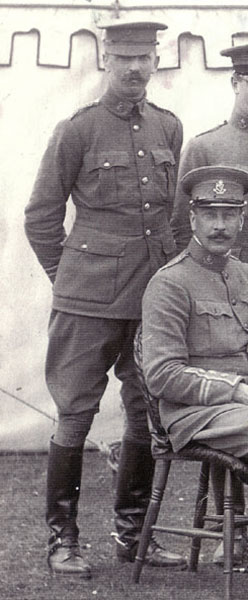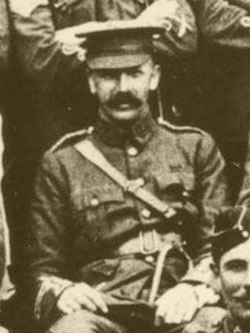Lieutenant-Colonel Richard Griffith Oliver Bramston-Newman
Richard Griffith Oliver Bramston-Newman was born on 19 January 1876, son of John Adam Richard Newman of Dromore, Mallow, Co Cork, and Maude Newman (nee Smith). A member of an old County Cork family, he was educated at Charterhouse and Sandhurst before being commissioned as a 2nd lieutenant in the 7th Dragoon Guards on 5 August 1896. He became a lieutenant on 9 June 1897 and captain on 24 January 1900.
Bramston-Newman served with the 7th Dragoon Guards in the Boer War, earning a Queen’s medal with four clasps, and, unfortunately, contracting enteric fever.
On 29 December 1901 he was seconded for service as Aide de Camp to Major General H.F. Grant CB, Inspector General of Cavalry in Great Britain and Ireland. When the North of Ireland Imperial Yeomanry was formed on 15 June 1903 he was seconded as its adjutant, a position that he held until 22 October 1907, when he was once again appointed to work for Grant, this time as Assistant Military Secretary and Aide de Camp in his role as commander in chief at Malta. In April 1909 he was awarded the Royal Victorian Order, Fourth Class (MVO).
Bramston-Newman retired on temporary retired pay on 17 November 1909, at the same time joining the North Irish Horse as a captain. On 12 December 1914 he was promoted to the rank of major. He arrived in France in November 1915 in command of F Squadron of the North Irish Horse, remaining in that post through 1916 and into 1917. There are a number of references to him in the diary of the 2nd North Irish Horse Regiment.
When the 2nd Regiment was dismounted and absorbed into the 9th Battalion Royal Irish Fusiliers in September 1917, Bramston-Newman was posted to the battalion, but did not join, instead facing a medical board which found him only fit for service in a garrison or labour battalion due to his being "prematurely aged owing to previous enteric fever in S. Africa."
He was ordered to join the North Irish Horse depot at Antrim. In March 1918 he was sent to France to command a Labour Corp group, with the rank of temporary lieutenant colonel, a position he held until June the following year.
Bramston-Newman was demobilized on 8 August 1919. He relinquished his commission on 19 January 1926, having reached the 50 year age limit for retention in the militia.
He died in Ireland on 3 December 1961.


The group photo from which the first image was taken, dated 1905, can be seen here. Images 2 and 3 show Bramston-Newman with fellow officers of the North of Ireland Imperial Yeomanry in 1904 and 1905.

